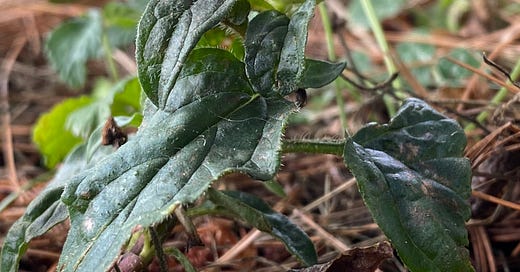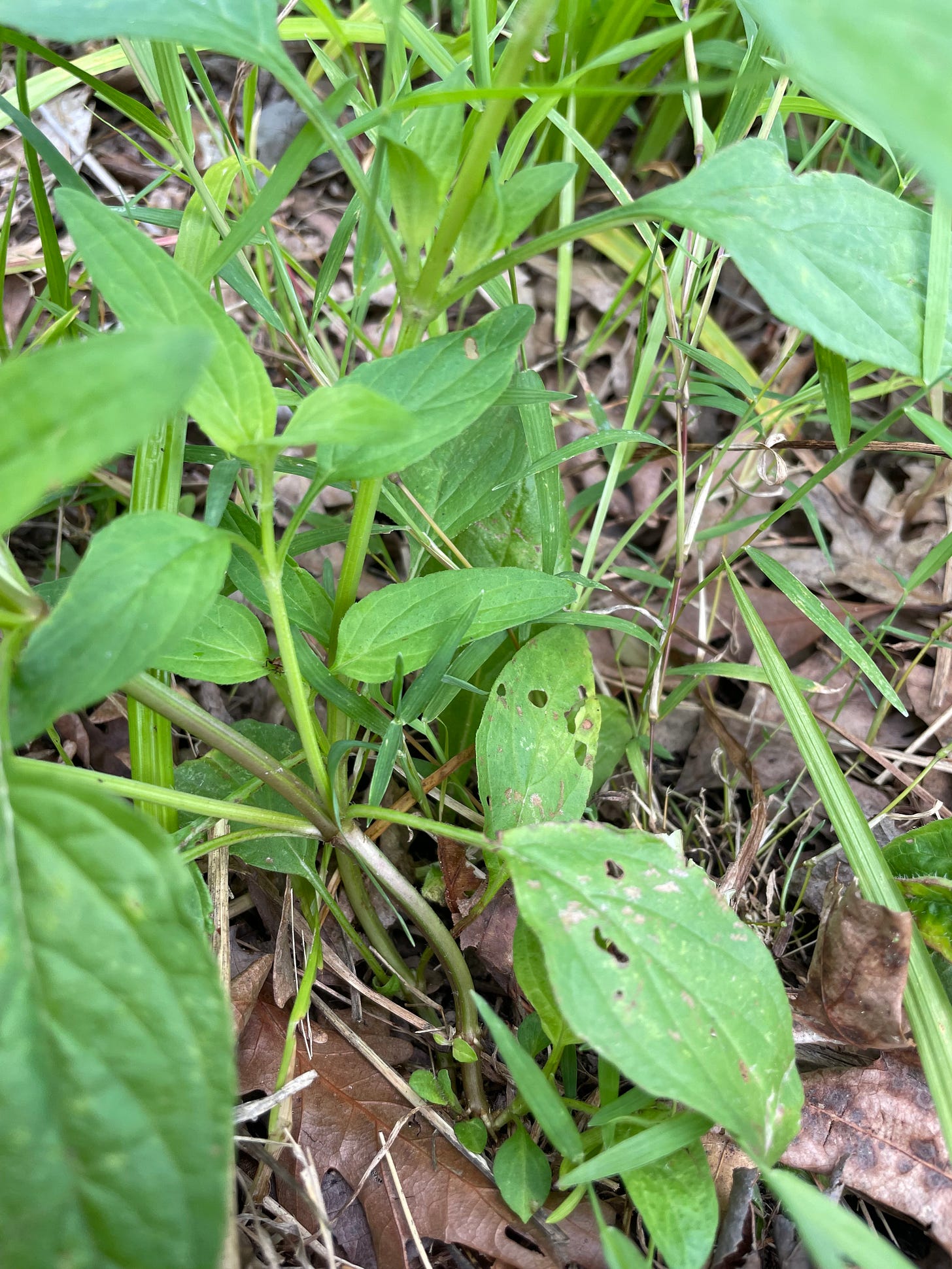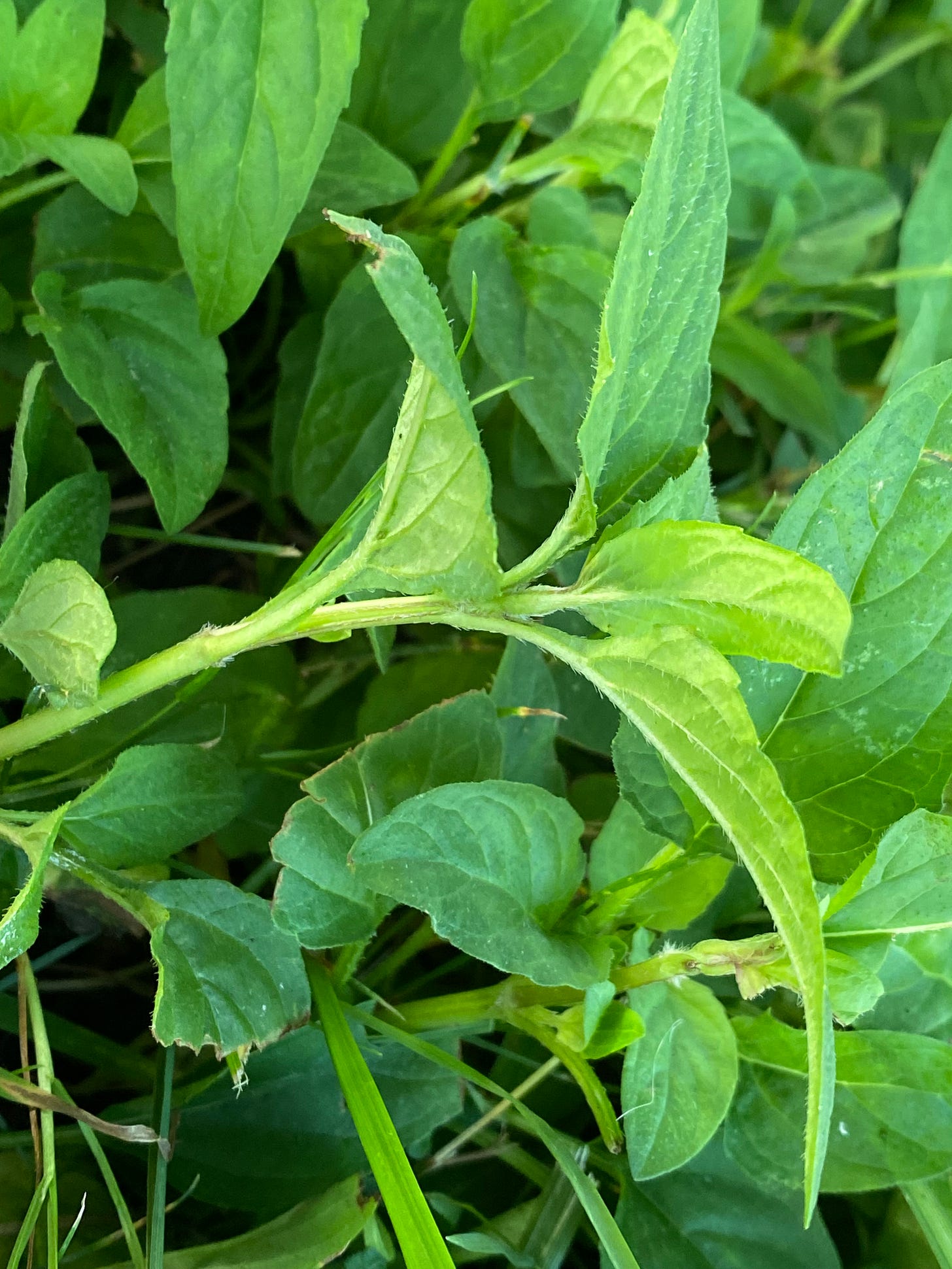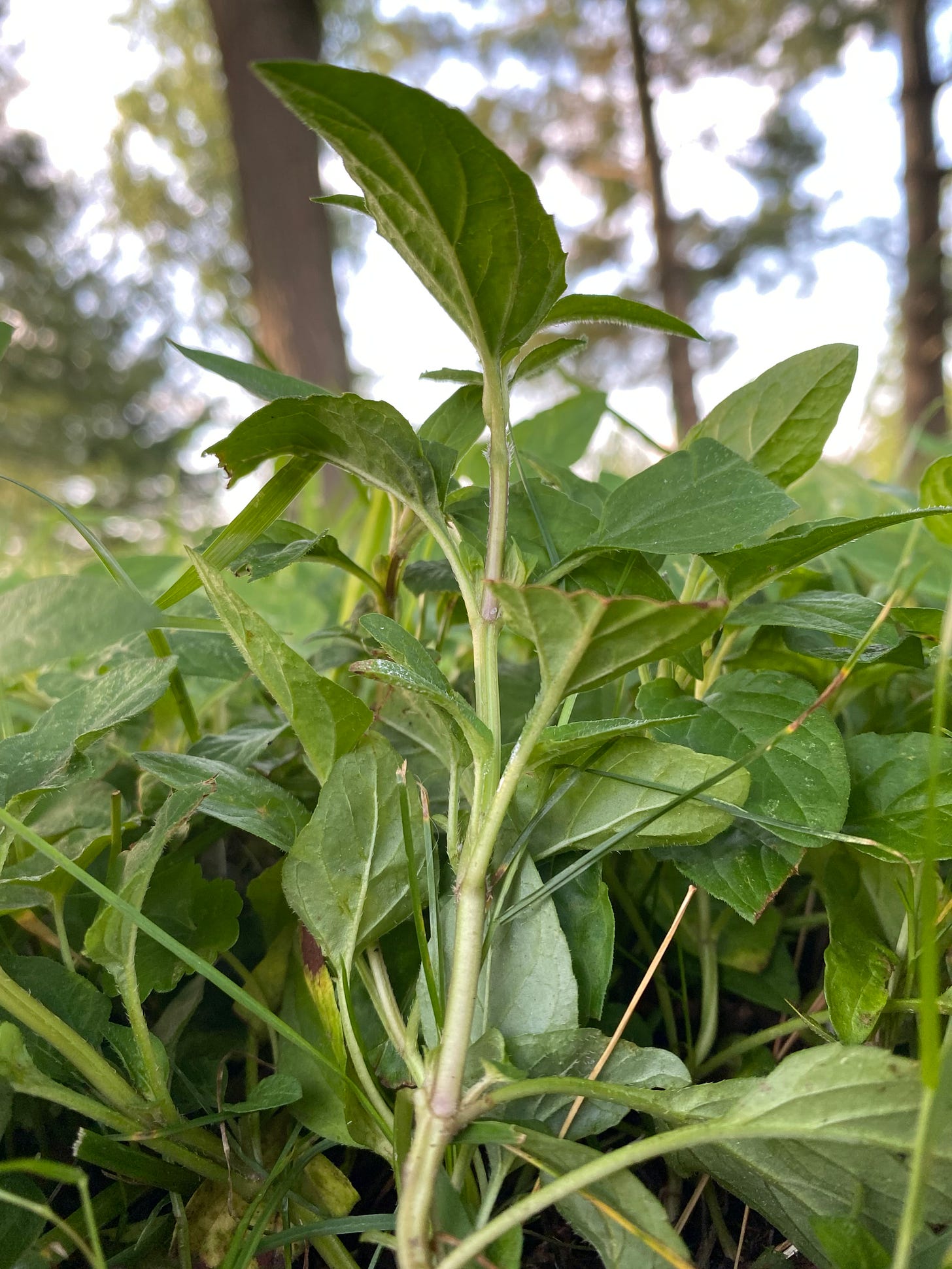Growing beneath the radar in the West, is heal all, a.k.a. self-heal or Prunella vulgaris. Though it is largely ignored in our part of the world the Chinese have multitudinous uses for this little weed, which is a mild means to address whatever ails you. Hsia-k’u ts’ao (Xia ku cao) is applied for such things as lymphadenopathy, goiter, hypertension, conjunctivitis, edema (as kidney and circulatory support), liver support, clearing congestion, and healing of abscesses. Traditionally, it’s regarded as a cold, bitter herb, used generously, in ~6-15 gram quantities of flowering heads per dose. Western herbalists agree that the herb is cooling, but in utilizing the whole herb, consider it both bitter and sweet. If you chew the leaves, you’ll taste sweetness and demulcent character, but there is a mild, bitter aftertaste. Wound healing, hemostatic effects, and immunomodulation are a few more its medicinal credits.
In June, when we braved the cleaning of our poison-ivy laden fence, an oval patch of heal-all had arisen to a full 2 inches, just south of our pine trees, and screamed for attention. They wanted recognition. They wanted to go viral! Unfortunately we can’t provide such full service until we become a little more famous. A few blooms have popped up, so now there enough photos to at least get our little buddies some face time online. Top recognition goes to the little weed that made it through the dry weather to flower profusely from a single, short spike, giving our best view of blooms at different angles.

There are said to be a number of sub-species of Prunella vulgaris, which often hybridize with other subspecies. Prunella vulgaris subspecies lanceolata is thought by some to be the native North American species, and Prunella vulgaris subspecies vulgaris is said to be the European variety. A third type, Prunella vulgaris subspecies asiatica is native to - guess where. There are numerous other interbreeding subspecies which have been claimed. At weedom, we won’t be surprised if the botanists eventually throw up their hands and give up sub-speciation with further attempts to study this weed.
Prunella vulgaris is a perennial inhabiting zones 4a through 9b, and flowering in North America throughout the summer. In the UK, these weeds continue flowering later into the fall. A member of the Laminaceae, the mint family, heal all has square stems, and a perennial habit. It spreads by seed and often by stolons, stems which can root at the nodes. This plant occupies fairly shady places, but can also tolerate nearly full sun, if given sufficient water. The leaves of more shaded plants seem consistently to be a much darker green. Considered by some to be invasive, heal all seems too small, mild and mellow to be a threat to anyone. It serves as food to numerous pollinator insects, and supports the lifecycle of the sulphur butterfly.
Once you’ve seen and handled heal all, you’ll notice it even before it blooms, even though this is a sprawling, short weed that is adept at ducking the lawnmower blades. The stems might reach 8 inches (20cm.) in height if left undisturbed, but frequently stubby little plants will flower throughout any area which is mowed. Leaves are lanceolate or ovate, (longer than wide) between and may reach a bit more than an inch, (3 cm.) in length. Like any good mint, they are arranged oppositely and in alternate directions along the square stem. The margins may be smooth or have some rounded teeth. Hairs line the central vein beneath the leaf, and may be further distributed on the underside and along the edges. Sparse hairs may occur on the upper side of the leaves also. Petioles are usually short, less than a centimeter in length.

The flowers are arranged in a circular pattern around a square or cylindrical looking spike with two leaves clasping the stem at the base. Each hairy bract produces 3 flowers, often one at a time. Tubular in shape, the flowers have an hooded purplish petal above, and a lower 3 lobed petal below, which is usually lighter in color. The larger middle lobe is fringed. As the flowers grow outward, they lighten in color. Each flower can produce 4 smooth, brown nutlets or seeds. Our little weeds usually flower throughout the Summer at weedom, (Midwest U.S.A., zone 6). This year they started in late June. Remembering this will ensure that they’re never confused with such things as henbit, or purple dead nettle which flower much earlier in Spring.

Below, hairs are visible both on the underside and the tops of the leaves.
Leaves are a bit lighter in color below, and the pinnately arranged veins are more prominently visible. If the plants escape mowing, they can branch a bit and creep along the ground, sending out roots from the nodes of stems.
Currently, our pharmacognosy friends in China are pretty excited about studying the 260 + compounds found in Prunella Vulgaris, including an array of triterpenoids, phenylpropanoids, flavonoids, organic acids, saccharides and numerous essential oils. This last group appears to mainly come from the flowering heads. The unbelievable array of active compounds in this plant gives a clue as to why it was widely applied in early times, and we will surely return to it in future articles.
Of recent interest is the mechanism of the anti-estrogen activity exhibited by this weed. It has been studied in mouse models of endometriosis, and observed to counteract the estrogen stimulated growth of these troublesome lesions of endometrial tissue that occur outside of the uterus. There seems not to be direct activity of Prunella vulgaris on the estrogen receptors themselves, but it seems to act on a different one, the aryl hydrocarbon receptor which modulates the transcription of genes that could be activated by estrogen (as well numerous exogenous molecules). This opens up understanding of how this plant could discourage estrogen dependent tumors or other types that are influenced by the aryl hydrocarbon receptor mechanism. Yes, our weed is being studied for anti-tumor activity and as an adjunct to chemotherapy.
One of the many antimicrobial actions available from this plant is the disruption of biofilms. It also has been credited with ability to inhibit the binding of such viruses as Herpes simplex II, HIV and human papilloma virus. One of the known antiviral constituents of our little weed is rosmarinic acid, a phenylpropranoid dimer that’s been the talk of the herb world for quite awhile. If you want an “organic” preservative, it’s a big one to keep in your memory banks. Rosmarinic acid ‘does it all’, being simultaneously antibacterial, anti-inflammatory, antioxidant, anti-allergic, etcetera. You’ll find this molecule in some more pedigreed mints too, such as rosemary, sage, lemon balm, and peppermint.
The earlier North American inhabitants employed heal-all to address eye ailments such as conjunctivitis, sore throats, and for gastrointestinal issues including diarrhea. This herb as both astringent and demulcent, was used to help to stop bleeding, and to soothe wounds and burns. Antimicrobial constituents served to help prevent infection, further assisting the healing of wounds. The tea was used to quell fevers.
The mild nature and relative safety of heal all places it in the status of a cooling medicinal food. Leaves can be eaten raw or cooked, and are particularly palatable prior to flowering. Flower heads might be considered to be too flavorful by some, though this writer thinks they taste OK while they’re still mostly green. Fresh or dried, the entire plant can be used to make a cooling and satisfying tea, which tastes a bit sweeter and milder than black tea, (Camellia sinensis). It can be used to adjust the flavor of medicinal tea formulas towards greater tolerability, and it does taste great by itself. Leaves can also be cooked and added to just about any dish which needs mild greens. Think about adding Prunella vulgaris into any honey formulations which are used to address colds and coughs. At weedom, we have some picking to do this month, to produce plenty of dried heal all for the winter.
Eyes down for bit when you get lost in the weeds this month! Find this excellent herb and experience it for yourself. Tell us what you think of it!
Where We Dig
1. Hunan Zhong yi yao yan jiu suo, ed. A Barefoot Doctor’s Manual. Rev. & enl. ed. Cloudburst Press ; distributed to the trade in the U.S.A. by S. Greene Press; 1977.
2. An Herbalist’s Guide to Using Self Heal. indie herbalist. Published April 25, 2019. Accessed July 19, 2023. https://blog.indieherbalist.com/an-herbalists-guide-to-using-self-heal/
3. Collins NH, Lessey EC, DuSell CD, et al. Characterization of Antiestrogenic Activity of the Chinese Herb, Prunella vulgaris, Using In Vitro and In Vivo (Mouse Xenograft) Models1. Biology of Reproduction. 2009;80(2):375-383. doi:10.1095/biolreprod.107.065375
4. Maier K, Gladstar R. Energetic Herbalism - A Guide to Sacred Plant Traditions Integrating Elements of Vitalism, Ayurveda, and Chinese Medicine. Chelsea Green Publishing; 2021. https://openlibrary.org/books/OL34171771M/Energetic_Herbalism
5. Ganora L. Herbal Constituents, 2nd Edition - Foundations of Phytochemistry. Lulu Press, Inc.; 2021. https://openlibrary.org/books/OL35083771M/Herbal_Constituents_2nd_Edition
6. Grieve M. Modern Herbal. Echo Point Books & Media, LLC.; 2015. https://openlibrary.org/books/OL36722889M/Modern_Herbal
7. Zhang X, Shen T, Zhou X, et al. Network pharmacology based virtual screening of active constituents of Prunella vulgaris L. and the molecular mechanism against breast cancer. Sci Rep. 2020;10(1):15730. doi:10.1038/s41598-020-72797-8
8. Zhao J, Ji D, Zhai X, Zhang L, Luo X, Fu X. Oral Administration of Prunella vulgaris L Improves the Effect of Taxane on Preventing the Progression of Breast Cancer and Reduces Its Side Effects. Frontiers in Pharmacology. 2018;9. Accessed July 19, 2023. https://www.frontiersin.org/articles/10.3389/fphar.2018.00806
9. Prunella vulgaris (Heal All, Selfheal) | North Carolina Extension Gardener Plant Toolbox. Accessed July 17, 2023. https://plants.ces.ncsu.edu/plants/prunella-vulgaris/
10. Cottrell V. Prunella vulgaris (self-heal). CABI Compendium. 2016;CABI Compendium:116556. doi:10.1079/cabicompendium.116556
11. Pan J, Wang H, Chen Y. Prunella vulgaris L. - A Review of its Ethnopharmacology, Phytochemistry, Quality Control and Pharmacological Effects. Front Pharmacol. 2022;13:903171. doi:10.3389/fphar.2022.903171
12. Qu Z, Zhang J, Yang H, et al. Prunella vulgaris L., an Edible and Medicinal Plant, Attenuates Scopolamine-Induced Memory Impairment in Rats. J Agric Food Chem. 2017;65(2):291-300. doi:10.1021/acs.jafc.6b04597
13. Prunella vulgaris Self-Heal, Common selfheal, Aleutian selfheal, Lance selfheal PFAF Plant Database. Accessed July 19, 2023. https://pfaf.org/user/plant.aspx?LatinName=Prunella+vulgaris
14. Wang SJ, Wang XH, Dai YY, et al. Prunella vulgaris: A Comprehensive Review of Chemical Constituents, Pharmacological Effects and Clinical Applications. Curr Pharm Des. 2019;25(3):359-369. doi:10.2174/1381612825666190313121608
15. Self Heal: Pictures, Flowers, Leaves & Identification | Prunella vulgaris. Accessed July 19, 2023. https://www.ediblewildfood.com/self-heal.aspx
16. Self-Heal: Herb of the Week · CommonWealth Holistic Herbalism. Published November 20, 2017. Accessed July 19, 2023. https://commonwealthherbs.com/self-heal-herb-of-the-week/
17. Selfheal - Prunella vulgaris | Washington College. Accessed July 19, 2023. https://www.washcoll.edu/learn-by-doing/food/plants/lamiaceae/prunella-vulgaris.php
18. Dar KA, Senthilmurugan S, Ali S, Al-Sadoon MK, Paray BA. Studies on the isolation and identification of the antibacterial compound from Prunella vulgaris L. Flower extract. Journal of King Saud University - Science. 2022;34(8):102324. doi:10.1016/j.jksus.2022.102324
19. Wood M. The Earthwise Herbal - A Complete Guide to Old World Medicinal Plants. North Atlantic Books; 2008. https://openlibrary.org/books/OL12031143M/The_Earthwise_Herbal
20. Cho MK, Jin L, Han JH, et al. Water-Extracted Prunella vulgaris Alleviates Endometriosis by Reducing Aerobic Glycolysis. Front Pharmacol. 2022;13:872810. doi:10.3389/fphar.2022.872810
21. Yin Yang House | Xia Ku Cao - Selfheal Spike, Prunella TCM Materia Medica. Accessed July 17, 2023. https://yinyanghouse.com/theory/theory/herbalmedicine/xia_ku_cao_tcm_herbal_database/










Beware serious harms while gathering small helps. Thank You for work published on substack .
First it important to understand - REALLY UNDERSTAND - tick bites can be life changing, life ending serious. Do not get bit in the first place and do not get bit again if possible.
From what I read of studies to assess tick bite reduction strategies, done with people actually working in the woods using the, "state of the art" methods (such as they are) - the result is that within too few years the failure rate is near 100% - most all will have a tick bite. What is needed is a truly tick proof coverall .
The need of the hour is a tick bite reduction strategy that is near 100% effective over a good length of time, usable, comfortable and cost effective, with the result that most all will be able to spend safe and enjoyable time in nature free from the tick bite and free from the bites of other insect pests. So in addition to such failure prone strategies so often recommended, what is needed is a truly tick proof coverall.
Such as, a portwest iona c814 or other, lightweight one piece cotton coverall with foam or fiber filled (perhaps including a full diameter plastic ring) fabric "tubes" sewn in circumferentially to the interior of the arms and legs and body of the garment to provide a stand off space from the body for bite through protection, additional bite through fabric or coating where body movement brings the coverall tight to the body AND coverall "attachments" ie. tick proof noseeum mesh oversocks or? attached to the inside of the pant leg, noseeum mesh gloves attached to the inside of the sleeves, which can be covered with work gloves or other attached appropriate tick proof gloves, and attached under collar stored tick proof noseeum mesh fabric veil to be used over a hat of your choice - all either tick proof sewn in or tick proof attachable/detachable with velcro or flange plastic zip lock zipper. A very near 100% tick-proof / bug proof over the long term, even for the tiny nymph stage tick, coverall which can then ,if desired, also be sprayed and treated. Nothing less makes sense with the multiple tick diseases, some very severe to fatal and without known and readily available treatment, POW for instance which is now in high concentration in the area of our northern Minnesota Tree Farm, and in consideration of what may be coming.
I have searched to no avail. Looks to me, at this time, to be a do it yourself "homemade" project.
An older "tree farmer" - needing and desiring to work in the woods for some years and stay TICK and bug bite DISEASE FREE.